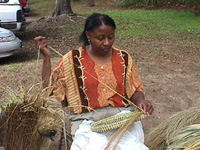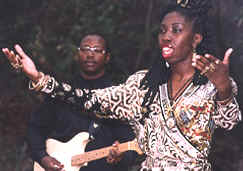
The Gullah/Geechee culture flourished on the islands off the South Carolina and Georgia coasts.

Gullah is an oral history, and younger generations have kept the traditional spirit of Gullah alive through language, religion, arts, crafts, stories, and song. Gullah/Geechee people reflect a more African influence in their behavior, self-expression, and beliefs than any other African American group in the United States of America.
- ENERGY & INTIMACY
- GIBSON AND GLOVER NEWS
- MOON NAMES
- MELANIN
- VISUALIZING LIGHT
- BLACK THINK TANK RESULTS
- DRIVING WHILE BLACK
- THE STATE OF OUR SOULS
- DISTRESSED BY STRESS?
- MONEY AND SPIRIT
- DIVINE CONVERSATION
- MANSHARING
- SEX AND SKIN
- THINK AND ACT
- Gullah-Geechee Culture
- BLACKS IN NAZI GERMANY
Queen
Quet has been
an indefatigable force to bring the culture and tenuous plight of her
people to public notice. She's testified before a world body, UNESCO, and,
largely, due to her energy, the Gullah Geechee area is being considered
for designation as a Heritage Area of the National Park System.
Add your voice in support of the Gullah's quest for independence. See the
report at http://www.nps.gov/sero/ggsrs/index.htm
Send your comments to: SERO_GullahGeechee_SRS_Team@nps.gov
Park Ranger Mike Allen says they have received less than 1,000 responses. Please, before February 2, take the time to send a note.
Gullah-Geechee
culture at the crossroads
By Audrey Peterman
Until February 1, 2004, individuals and groups around the country have an
unprecedented opportunity to help decide the fate of a living culture,
unique to America's shores. The Gullah-Geechee culture, in its birthplace
along the islands bordering Georgia and South Carolina is priceless for
its uniqueness, rarity and authenticity as the flowering of African
culture adapted to its American environment. But, as the people and place
are threatened by encroaching development, the Gullah-Geechee Sea Islands
may be recommended for protection by the federal government as a National
Heritage Area, under the auspices of the National Park System.
Through a Special Resource Study initiated in 1999 by Congressman James
Clyburn (D-SC), a team of researchers from the National Park Service has
traveled through the area for two years, holding meetings with members of
the community to determine the most feasible ways to preserve this
inimitable culture and lifestyle. The NPS is currently taking input from
interested people on the following five options suggested by the research
team, which will then be presented to Congress with recommendation for one
or more options to be pursued:
-
Build three cultural heritage centers, museum-like facilities, at current state or federal parks in northern Charleston County, at Penn Center on St. Helena Island in Beaufort County and in McIntosh County, GA.
-
Expand displays about Gullah at existing sites such as Charles Pinckney National Historic Site, Hampton Plantation State Historic Site and Sapelo Island National Reserve, and potentially other sites managed by the local, state or federal government.
-
Create a Gullah-Geechee National Heritage Area. The heritage area designation would help various public and private groups work together to highlight their stories.
-
Combine the culture heritage centers and a heritage area.
-
Take no action.
"The
community prefers the National Heritage Area above all of the alternatives
because we remain in control of telling our own story," said Queen
Quet, chieftess of the Gullah-Geechee Nation and a St. Helena resident.
"The people that live the story are the true keepers of culture and
should be respected as such."
Queen Quet, who writes, travels and speaks prolifically on the issue and
has testified before the United Nations about the need to preserve her
culture, wants federal officials to bring in Gullah community leaders as
partners in creating the Heritage Area.
"We see this Study as an opportunity to recognize a part of our
American fabric and energize the interpretation of Gullah heritage,"
said National Park Service Ranger Michael Allen, who has been instrumental
in helping put together the project for the National Park Service, and was
recently honored by the US Congress for his outstanding contribution to
preserving American history.
Stretching along the southeastern coast roughly from the Cape Fear River
near the North Carolina/South Carolina line to the St. John's River near
the Georgia/Florida line, the Sea Islands area extends 30 miles inland and
encompasses approximately 12,315 square miles, nearly the size of the
state of Maryland.
Gullah-Geechee people of today are descendants of enslaved Africans from
various ethnic groups of west and central Africa who were forced to work
on the plantations of coastal South Carolina, Georgia, North Carolina, and
Florida. The Gullah- Geechee people are survivors - unique groups of
African-Americans who lived near the coast and on barrier islands that
were separated from the mainland by creeks, rivers, and marshes. Because
of their geographic protection from outsiders and strong sense of family
and community, Gullah-Geechee people maintained a separate creole language
and developed distinct culture patterns, which included more of the
African cultural tradition than African-American population in other parts
of the United States.
The isolation of these sea island communities from outsiders was vital to
the survival of the cultures. Although the Gullah-Geechee people traveled
to and from the mainland and to nearby islands, outsiders seldom came into
their communities, especially after the Civil War. Their isolation, which
began in colonial times in response to tropical fevers, later became an
isolation of choice. People chose to come back to their homes, their
families, their language, and their way of life - a slow-paced life among
majestic trees, tidal marshes, and dirt roads traversed by ox and mule
carts - places where small boats, horses, mules and feet were the primary
forms of transportation. Thus, within these rural communities, people were
able to maintain their language, arts, crafts, religious beliefs,
folklore, rituals and food preferences that are distinctly connected to
their West African roots. The islands were accessible only by boat until
the first bridges were built around 1950.
Nowhere else on the face of the Earth can one experience this special mix
of the African and American. Influences of the Gullah-Geechee culture are
widely dispersed across the country.
"Most
Americans have no idea how many African Americans are "touched"
by what some of us grew up calling "Geechee" culture, "
says Al Calloway from Fort Lauderdale, FL. "The church I grew up in
-- The Metropolitan AME Methodist Church in Harlem, New York City -- had
an original membership of mostly first generation removed South
Carolinians and Georgians. They came from the Charleston area and the
Islands around, as well as from coastal Georgia. The red rice, greens,
candied yams, deep fried chicken and cornbread cooked every Sunday at
church, and the accents and strange words used and understood, especially
by the adults, gave a sense of belonging to a tradition far different from
the fare encountered outside those walls. The music was haunting,
spiritual, deep gospel. All the way from Mother Africa."
Now you, too, can experience it in its birthplace and influence its fate.
The report may be viewed at http://www.nps.gov/sero/ggsrs/index.htm
We
encourage you to send your comments to:
SERO_GullahGeechee_SRS_Team@nps.gov
or to:
John Barrett
National Park Service
100 Alabama St., SW
Atlanta, GA 30303
GullGeeCo@aol.com
Links to sites:
Gullah/Geechee
Sea Island
Coalition




